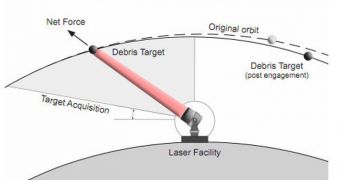Scientists with the American space agency are proposing the use of ground-based laser system for cleaning up debris in low-Earth orbit (LEO). The system could be constructed inexpensively, but it will provide satellite operators with more room for their spacecraft.
At this point, Earth is surrounded by tens of thousands of small fragments, originating from colliding satellites and rocket launches. One can easily identify chips of paint, spent rocket stages, bolts, and other debris flying around at most altitudes.
This space junk is threatening spacecraft being launched from Earth to an orbital perch. This is why experts have been working on developing a plan that would see them gone. But developing such a plan proved to be more difficult than experts anticipated.
The thing about space debris is that they continuously accumulate, fed by a feedback loop. As more junk is produced, the chance of it impacting something, and creating more junk, increases.
Donald Kessler, a former NASA scientist, showed in 1978 that the rate at which debris form is higher than the rate at which it deorbits and burns in the atmosphere. As such, we run the risk of literally clogging our planet's orbit.
Now, experts with the NASA Ames Research Center (ARC) propose a new method for taking care of business, one that is not hugely expensive, and that can also be implemented rather easily.
The team says that a powerful laser could be aimed from Earth at individual space junk, zapping them for long enough to ensure that the debris' speed decreases substantially. When this happens, their orbit modifies, and they begin burning up in the atmosphere.
In a bid to alleviate possible concerns that the laser could be used as a space weapon, Mason and his colleagues proposed that the instrument should only have a power output of 5 kilowatts (kW).
This of course means that the laser needs to be aimed at each individual piece of garbage for about 60 to 120 minutes. At this rate, such an instrument would eliminate 10 to 20 pieces of debris daily, Technology Review reports.
Estimates place the cost of such a device at around $1 million, and the NASA team says that an array of them would be needed to get the job done in time. The lasers would also need to be divided among nations, so as to alleviate concerns of improper use.
Bottom line is that dealing with space junk is something that we have to do today, if not for anything else, then for the fact that we have manned crews flying to the International Space Station (ISS).
The space lab itself, home to six permanent residents, is threatened by space debris, and mission controllers had to move it out of the way to avoid impact several times over the past few years.

 14 DAY TRIAL //
14 DAY TRIAL //